#한국어공부하기
Photo

If you're learning Korean, you might have encountered the word "어차피" (eo-cha-pi) at some point. It's a useful word that can be translated to "anyway," "in any case," or "after all." When you use "어차피," you're often indicating that something is inevitable or necessary, regardless of other circumstances.
To use "어차피", you simply need to add it to the sentence.
E.g.
어차피 늦었으니까 천천히 와.
(It's late anyway, so take your time.)
어차피 다른 선택지가 없어.
(There’s no other option anyway.)
그 사람은 어차피 나를 싫어하는 거야.
(That person hates me, after all.)
"어차피" is often used with grammar like ~(으)니까 or -(으)ㄴ/는데 to add more context.
E.g.
어차피 해야 할일이니까 빨리 하고 끝내는게 좋지않겠어요?
(Because it's something you have to do anyway, isn't it better to hurry up and finish it?)
어차피 시간이 없는데 일찍 가는 게 좋을 거야.
(Anyway, since we don't have much time, it's better to leave early.)
어차피 지나간 일이니까 다시 말하지 말아요.
(Since it's a thing of the past anyway, let's not talk about it again.)
어차피 밖에 비가 내리고 있는데 조금더 이야기를 나누자
(It's raining outside anyway, so let's talk a little bit more.)
🌸 🌼 🌻
Support me at: https://koreanlanguageloving.my.canva.site/
#Korean Language#korean langblr#Learn Korean#Study Korean#Hangul#한국어 공부하기#한국어 배우기#한국어 어휘#한국어 연습#한국어#한국어능력시험#한국어공부해요#한국어공부중#한국어공부하기#한국어공부#Korean Vocabulary
344 notes
·
View notes
Photo

내 한국어 많이 늘고 있으니까~ 고맙다 샘~! Because my korean is getting better~ Thanks, teacher~! #한국말 #한국어 #한국어공부하기 #한국어능력시험 #TOPIK (The Coffee Bean and Tea Leaf - SM Megamall에서)
0 notes
Video
[한국어공부하기] 영어로 배우는 비타민 한국어 2 (2)
#한국어동스쿨 : http://bit.ly/2Hywv4N
#한국어인강, #한국어배우기, #한국어강의, #한국어온라인강의, #외국인한국어공부
▣ 강좌소개
This is a Korean course for beginners who have finished learning very basic Korean. It provides video lectures for learning Korean in English so that they can learn useful expressions, vocabulary, and grammar. Learners can be confident in conversation and get help to prepare for TOPIK.
한국어 기초 학습이 끝난 초급 학습자를 대상으로 하는 초급 한국어 과정으��, 한국에서 자주 사용하는 표현, 어휘, 문법을 익힐 수 있게 영어로 한국어를 배우는 강의입니다. 회화뿐만 아니라 TOPIK을 준비하는 학습자까지 한국어에 자신감을 가질 수 있습니다.
▣ 학습대상
1. Learners who have completed learning very basic Korean
2. Learners who want to learn Korean expressions in use
3. Learners who want to learn essential Korean grammar for TOPIK
1. 한국어 기초 학습이 끝난 한국어 초급 수준의 학습자
2. 일상생활에서 자주 사용되는 한국어 표현을 배우고자 하는 학습자
3. 'TOPIK' 대비에 필수 요소인 한국어 문법을 배우고자 하는 학습자
▣ 학습목표
This course will provide learners with:
1. frequently used expressions, vocabulary and grammar
2. how to improve their communication skills in Korean and prepare for TOPIK
3. an in-depth understanding about Korean culture based on the language
1. 한국에서 자주 사용되는 표현, 어휘 및 문법을 배울 수 있습니다.
2. 한국어로 의사소통 능력은 물론 'TOPIK' 시험도 대비할 수 있습니다.
3. 한국어를 기반으로 자연스럽게 한국 문화를 익힐 수 있습니다.
강의 커리큘럼
1. The cold got worse.
2. I want to send a parcel to New York, How long does it take?
3. I will exchange only 100,000 won.
4. Exercise 5
5. Exercise 6
6. Have you ever been to Gyeongju?
7. I exercise while listening to music.
8. If you have questions, please ask me anytime.
9. Exercise 7
10. Exercise 8
강의 페이지 : https://www.kordong.com/kor/lecture_detail.php?id=44
0 notes
Photo

ㅋㅋ. . . 아까 전에 편의점에서 구매했음. . 영화도 보고 싶어졌다. 내용은 거의 다 내 기억희로에 저장되어 있지만. . ㅋ 한국어공부하기 위해서도^^ 📚📝学士時代から幾度となく読みあさってきたフィッツジェラルド。深夜の風呂敷残業の合間にふらりとコンビニに立ち寄ったところ、レジ前にあったポケット版ギャツビー...😅内容はほぼ完璧に記憶回路に保存されているのにもかかわらず懲りもせずに(笑)韓国語バージョンなので語学のお勉強にも良いでしょう^_^ . #韓国生活 #책스타그램 #韓国語の勉強 #深夜の読書 #華麗なるギャツビー #책벌레 #한국생활 #위대한개츠비 #일상스타그램 #일상 #여유공간 #한국어공부 #인스타그램 #미국문학 #本の虫 #本のある生活 #本スタグラム #bookstagram #bookworm #북스타그램 #외국어 (Seoul, South Korea에서)
#本スタグラム#bookworm#위대한개츠비#한국어공부#외국어#한국생활#미국문학#책벌레#本のある生活#인스타그램#일상스타그램#華麗なるギャツビー#bookstagram#深夜の読書#韓国生活#일상#本の虫#북스타그램#韓国語の勉強#책스타그램#여유공간
1 note
·
View note
Photo
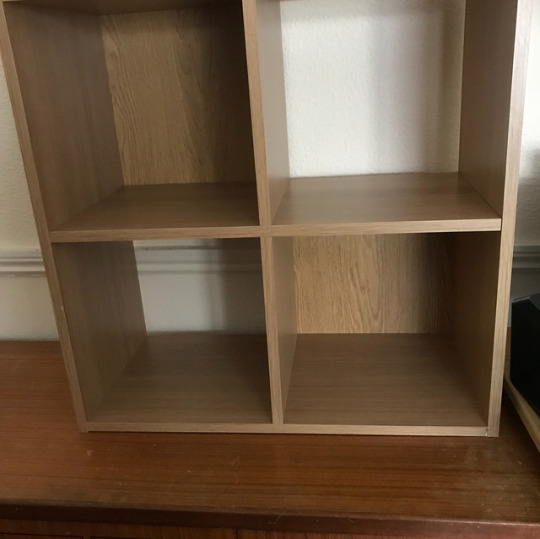
I made this bookshelf today. So I thought I’d show you all my Korean books and stationary. Not all the books are here. My daughter @gosia_antosiewicz is also studying so she has 2 books in her room. 오늘은 책장을 만들었어. 그래서 모든 한국어공부책과 문방구를 보일 거야.모든 책을 여기에 없어. 딸도 한국어를 공부해서 방에 초보자를위한 2 권의 책이 있어. #korean #studying #한국어공부하기 #kpop #language #learning #studying #lowerintermediate
0 notes
Photo
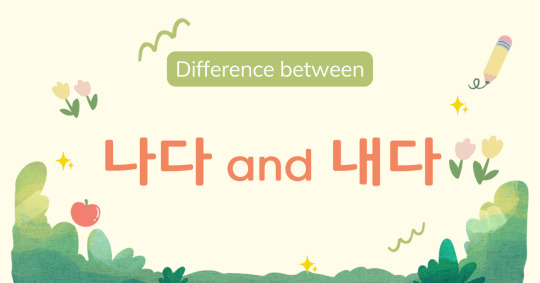
If you're learning Korean, you may come across words that end in either 나다 (nada) or 내다 (naeda), such as 끝나다 and 끝내다, 고장나다 and 고장내다. Both 나다 and 내다 can be used as standalone verbs or combined with other words to create compound verbs. These verbs can have complex meanings and depend heavily on the context in which they are used.
To clarify the differences between the two, let's break it down:
(1) "나다" describes something that happens on its own or spontaneously, without external influence. It can be translated as "to come up," "to arise," or "to occur".
For example"
텔레비전이 고장났어요.
(The television broke down)
In this case, 고장나다 is used because the television broke down on its own, without any external force causing it.
Another example:
영화가 끝나서 집에 가야 돼요.
(The movie is finished, so I have to go home.)
Here, 끝나다 is used because the end of the movie is a natural occurrence that happens on its own.
Note that 나다 is often used with the particle 이/가 to indicate the subject of the sentence, as in:
소리가 나다: to sound (sound coming up on its own)
소방차의 경적 소리가 나서 모든 차들이 길을 비켜갔어요.
(The siren of the fire truck went off, and all the cars moved out of the way)
화가 나다: to get angry (the feeling of anger arising within the speaker)
난 지금 엄청 화가 났어. 건드리지 마.
(I’m really angry right now. Don’t touch me.)
(2) "내다" describes something that happens as a result of external influence or intervention. It can be translated as “to make something come up” or “to cause something to arise."
For example:
누군가 텔레비전을 고장냈어요.
(Someone broke the television.)
In this case, 고장내다 is used because the television breaking down was caused by an external force.
Another example:
선생님이 수업을 끝내냈어요.
(The teacher finished the class.)
Here, 끝내다 is used because the end of the class was caused by the teacher actively ending it.
Note that 내다 is often used with the particle 을/를 to indicate the object of the sentence, as in:
소리를 내다: to make a sound (actively making a sound)
그들은 악기를 연주하여 아름다운 소리를 냈어요
(They played their instruments and made beautiful sounds.)
화를 내다: to get angry (the anger is showed outside verbally or by actions)
화가 나도 다른 사람에게 화를 내면 안 돼.
(Even if you’re angry, you shouldn’t take it out on other people.)
It's important to note that not all Korean verbs that end with either “나다” or “내다” have an equivalent form ending in the other.
In summary, “나다” is used when something happens spontaneously or independently, while “내다” is used when something happens as a result of external influence or intervention.
#KoreanGrammar #LearnKorean #KoreanVocabulary
🌸 🌼 🌻
Support me at: https://koreanlanguageloving.my.canva.site/
#한국어#한국어 문법#한국어 연습#한국어 공부하기#Hangul#Korean Language#korean langblr#Korean Vocabulary#learn korean#Study Korean#한국어공부중#한국어공부해요#한국어공부#한국어공부하기#한국어능력시험
123 notes
·
View notes
Photo

날지 못하면 달려라. 달리지 못하면 걸어라. 그리고 걷지 못하면 기어라, 당신이 무엇을 하든 앞으로 가야 한다는 것만 명심해라.
– 마틴 루터 킹 주니어
If you cannot fly then run. If you cannot run, then walk. And, if you cannot walk, then crawl, but whatever you do, you have to keep moving forward.
– Martin Luther King Jr.
✏️ 𝐕𝐨𝐜𝐚𝐛𝐮𝐥𝐚𝐫𝐲:
날다: fly
달리다: run, dash
걷다: walk
기다: crawl
그리고: and
무엇: anything, something
앞: front
가다: go
명심하다: keep (sth) in mind, bear (sth) in mind, be sure to remember
✏️ 𝐆𝐫𝐚𝐦𝐦𝐚𝐫:
1. V~지 못하다 = cannot V
E.g. 날지 못하다 = cannot fly/ be unable to fly
2. V~아/어 라 = used when the speaker demands or directs the listener for doing some work.
E.g. 날지 못하면 달려라 = If you can't fly, run
#KoreanVocabulary #KoreanLanguage #quotesdaily
🌸 🌼 🌻
Support me at: https://koreanlanguageloving.my.canva.site/
#Korean Language#korean langblr#Learn Korean#Study Korean#Hangul#Korean Quotes#positive quotes#한국어 배우기#한국어 단어#한국어 공부하기#한국어배우기#한국어 연습#한국어공부중#한국어#한국어공부해요#한국어공부#한국어공부하기
74 notes
·
View notes
Photo

Have you ever heard of the term "소확행"?
"소확행" is a shortened version of "소소하지만 확실한 행복," which translates to "small but certain happiness." It's a way of saying that happiness doesn't have to come from big accomplishments or expensive possessions. Instead, it can be found in the small moments and experiences of everyday life.
소소하다 (adj): small
확실하다 (adj): certain, sure
행복 (n): happiness
So, what does “소확행” look like? Here are a few examples:
산책하며 신선한 공기와 햇살을 즐기기 (Going for a walk and enjoying the fresh air and sunshine)
가족이나 친구와 좋은 대화 나누기 (Having a good conversation with a friend or family member)
마음에 드는 음식이나 음료 즐기기 (Enjoying your favorite food or drink.)
몇 분 동안 명상하거나 정신 수행하기 (Taking a few minutes to meditate or practice mindfulness)
그림 그리기, 춤추기, 음악 듣기 등 자신에게 기쁨을 주는 취미 활동하기 (Doing hobbies that give you joy, such as drawing, dancing, and listening to music.)
So take a moment to appreciate the little things and find joy in the present moment – you might be surprised at how much happiness you can find in the small but certain pleasures of life!
---
🌸 🌼 🌻
Support me at: https://koreanlanguageloving.my.canva.site/
#Korean Language#korean langblr#Lean Korean#Study Korean#Korean Vocabulary#korean slang#korean studyblr#한국어 배우기#한국어 단어#한국어능력시험#한국어#한국어수업#한국어공부해요#한국어공부하기#한국어공부#한국어공부중
116 notes
·
View notes
Photo
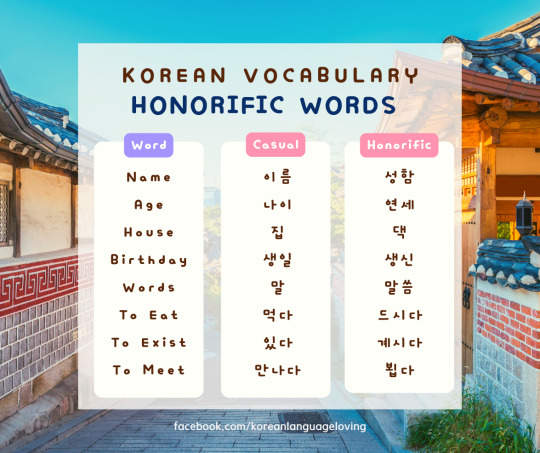
Respect is essential in Korean culture, and it's reflected in the language. Honorifics are used to show respect, and they indicate relative status within a group. When speaking to someone older or higher in rank, use the formal speech level ending with ~ㅂ니다.
There are lots of honorific words in Korean, including nouns, pronouns, and titles. Here's a list of some common ones to get you started!
𝐍𝐨𝐮𝐧𝐬
이름 –> 성함 (Name)
나이 –> 연세 (Age)
집 –> 댁 (House, Home)
생일 –> 생신 (Birthday)
말 –> 말씀 (Words)
밥 –> 식사 (Meal)
사람 –> 분 (Person)
아빠 –> 아버님 (Father)
엄마 –> 어머님 (Mother)
𝐕𝐞𝐫𝐛𝐬
Rather than simply adding -(으)시다, the following verbs have a special honorific version.
먹다 –> 드시다 (To Eat)
마시다 –> 드시다 (To Drink)
있다 –> 계시다 (To Exist)
만나다 –> 뵙다 (To Meet)
자다 –> 주무시다 ( (To Sleep)
말하다 –> 말씀하다 (To Speak)
묻다 –> 여쭙다 (To Ask)
주다 –> 드리다 (To Give)
𝐒𝐞𝐧𝐭𝐞𝐧𝐜𝐞 𝐄𝐱𝐚𝐦𝐩𝐥𝐞𝐬:
성함이 어떻게 되세요? (May I have your name?)
연세가 어떻게 되세요? (May I ask your age?)
처음 뵙겠습니다 (It is nice to meet you)
잘 부탁드립니다 (Please take care of me)
🌸 🌼 🌻
Support me at: https://koreanlanguageloving.my.canva.site/
#Korean langblr#Korean Language#Hangul#Learn Korean#Study Korean#한국어능력시험#한국어 단어#한국어 배우기#한국어 어휘#한국어공부중#한국어배우기#한국어#한국어수업#한국어공부해요#한국어공부하기#한국어공부#korean vocabulary
141 notes
·
View notes
Photo
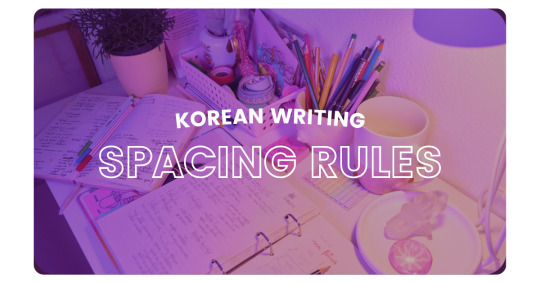
Writing in Korean can be quite complex when it comes to spacing (띄어쓰기), as it involves several factors like grammar, sentence structure, and even the type of words. In this article, I’ll share some of the most important rules I’ve learned with you.
1. Particles:
Korean uses particles to indicate grammatical relationships between words in a sentence. To ensure clarity, it is essential to separate these particles from the following words. Some commonly used particles in Korean include 은/는, 이/가, 을/를, 에, 에서, (으)로, 에게, 도, 와/과, and so on.
For example, in the sentence “저는 한국에서 떡볶이를 먹었습니다” (I ate Tteokbokki in Korea), there are three particles used: 는, 에서, and 를. To make it clear, it is essential to add spaces after each particle.
It is essential to note that particles are included as part of the preceding word. Therefore, particles are not standalone words and should be attached to the word they modify without spaces.
2. Independent Nouns:
In some sentences, there may be two or three nouns put together to form a noun phrase. In constructing such phrases, it is generally advisable to separate each independent noun with a space.
For example, “한국 음식” (Korean Food) and “경영 대학교” (Business University) both consist of multiple nouns that should be separated by spaces.
However, there are exceptions to this rule:
Compound Words: When words are combined to create a new meaning, they should be written without spaces. For example, “tear” in Korean is “눈물”, a compound word made up of 눈 (eyes) and 물 (water). This word should be written together as “눈물” without a space between them. The same applies to verbs such as “to visit,” which is “방문하다”, a compound word made up of “방문” (visit) and “하다” (to do).
Proper Nouns: If the noun phrase is a commonly used or official name, such “한국관광공사” (Korean Tourism Organization) or “국립중앙박물관” (National Museum of Korea), it is standard to write the entire phrase without spaces. Doing so makes it more easily recognizable as a specific entity or organization.
3. Person’s Name and Title
Korean personal names consist of a surname and a given name, both of which have independent meanings and can be used as separate words. Although it can be argued that they should be written separately, personal names are unique nouns, and Korean surnames are usually only one syllable, making them feel incomplete on their own. Therefore, it is customary to write personal names without spaces between the surname and given name.
For example, “Park Ji-min” is written as “박지민,” “Kim Min-seok” is “김민석,” and “Lee Min-ho” is “이민호,” all without spaces.
However, when titles or job names follow a personal name, they are separate units and should be written with a space between them.
For example: 박지민 씨 (Mr. Park Ji-min), 민수철 교수 (Professor Min Su-cheol), 김 의사님 (Doctor Kim) all have a space between the personal name and the title or job name.
4. Numbers and counters:
In Korean, spacing is used between every ten thousand when writing numbers. This means that if you have a number with five digits or more, you will use a space to separate the digits in groups of four.
For example:
이천이십삼 (2023)
구만 팔천칠백육십오 (98765)
일억 이천삼백사십오만 육천칠백팔십구 (123456789)
When it comes to combining numbers with counters, there are two cases to consider:
If you write the number in digits, there is no space between the number and the counter. For example, “1개” (one piece), “2번” (two times), and “3명” (three people) have no space between the number and the counter.
However, if you write the number in words, there should be a space between the written number and the counter. For example, “삼 학년” (third grade), “칠천 원” (seven thousand won), and “칠 개월” (seven months) have a space between the written number and the counter.
5. Word modifiers:
When a modifier (such as an adjective, verb, or adverb) modifies a word, it should be separated from the word by a space. This helps to clarify the relationship between the two words and make the sentence easier to read.
For example:
유나는 예쁜 여자예요 (Yuna is a pretty girl)
한국 와서 처음 먹은 음식 기억나요? (Do you remember the first food that you ate in Korea?)
저는 일을 잘 해요 (I do my job well)
All use spacing to separate the modifier from the word.
Additional Notes:
– It’s worth noting that there are certain grammatical structures in Korean that require specific spacing. For example, “(으)ㄴ 적이 있다” (have done in the past), “(으)ㄹ 수 있다” (can/be able to), “아/어 보다” (try doing) and so on. It’s important to pay attention to these spacing rules when learning Korean to ensure that your writing is accurate and clear.
– Finally, when using “이다” (to be) or “아니다” (to not be), it’s important to note that “이다” is written immediately after a noun, while “아니다” is written separately from the noun due to the particle. This is important to keep in mind when writing sentences that use these verbs.
For example:
학생입니다 (I’m a student)
학생이 아닙니다 (I’m not a student.)
The preceding explanation outlines my current understanding of the spacing rules when writing in Korean. However, I also want to point out that there might be some special cases or exceptions to these rules that I’m not aware of. So, if you have any experience with these special cases, I’d love to hear about it! Let’s share our knowledge and learn from each other.
🌸 🌼 🌻
Support me at: https://koreanlanguageloving.my.canva.site/
#Korean Language#Learn Korean#Study Korean#Hangul#korean langblr#Topik Writing#Korean Writing#Korean Topik#한국어공부중#한국어공부해요#한국어공부하기#한국어공부#한국어 공부#한국어#한국어수업#한국어 수업#한국어능력시험#Learning Tips#korean grammar
113 notes
·
View notes
Photo

선택에 후회하지 마세요.
그 순간에는 그 선택이 당신의 최고의 선택이었을 테니까요.
Don't regret your choices.
At that moment, that choice was probably your best choice.
✏️ 𝐕𝐨𝐜𝐚𝐛𝐮𝐥𝐚𝐫𝐲:
1. 선택: choice, selection
2. 후회하다: regret, feel remorse, repent
3. 순간: moment
4. 당신: you
5. 최고: the best
✏️ 𝐆𝐫𝐚𝐦𝐦𝐚𝐫:
1. V + 지 마세요: "Don't do (something)" or "Don't (verb)" ~ give a command or request in the negative form.
E.g. 후회하지 마세요 = Don't regret
2. A/V + ㄹ/을 테니까요: "since" or "because" ~ indicate a supposition or assumption based on a certain situation or condition
E.g.
최고의 선택이었을 테니까요 = It would have been the best choice
---
🌸 🌼 🌻
Support me at: https://koreanlanguageloving.my.canva.site/
#Korean Quotes#Korean Phrases#Lean Korean#Study Korean#Study with me#Hangul#korean langblr#한국어공부중#한국어공부해요#한국어공부하기#한국어 공부하기#한국어공부#한국어#명언
68 notes
·
View notes
Photo

Korean Phrases to Encourage Your Kpop Idols
1.화이팅 (hwaiting) – This is a popular cheer-up phrase that’s commonly used in Korea. It’s often translated as “fighting” or “let’s go”.
2. 잘하고 있어요! (Jalhago isseoyo!) – This phrase means “You’re doing well!” or “You’re doing a good job!”
3. 오늘도 수고 많았어요 (oneuldo sugo mannatseoyo) – This means “You did a great job today” and is commonly used among not just K-Pop idols but also Koreans.
4. 자랑스러워요 (jarangseureowoyo) – This phrase means “I am proud of you”
5. 오늘도 멋있었어요 (oneuldo meosisseosseoyo) – This means “You were cool today, too”
6. 힘내세요! (Himnaeseyo!) – This phrase means “cheer up!” or “stay strong!”
7. 사랑해요 (saranghaeyo) – This means “I love you”
8. 좋은 일만 있길 바라요 (joheun ilman itgil barayo) – This phrase means “I hope only good things happen to you.”
9. 늘 응원할게요 (neul eungwonhalgeyo) – This means “I will always cheer you on.” or “I will always support you”.
10. 절대 포기하지 마세요 (jeoldae pogi haji maseyo) – This means “never give up.”
11. 꿈을 이루길 바랄게요 (ggumeul irugil baralgeyo) – This phrase means “I hope your dreams come true.”
12. 당신은 최고예요 (dangshineun choegoyeyo) – This means “you are the best.”
13. 저희는 항상 당신과 함께 있어요 (jeohui-neun hangsang dangsin-gwa hamkke isseoyo) – This means “we are always with you.”
14. 당신의 꿈을 응원합니다 (dangsin-ui kkumeul eungwonhamnida) – This means “I support your dreams.”
15. 당신은 끝까지 할 수 있어요 (dangshineun kkeutkkaji hal su isseoyo) – This means “You can do it until the end”
Notes: You can replace “당신” with your idol’s name in the sentence number 12, 13, 14 and 15 to make it more personal.
For example:
If your idol’s name is Jungkook, you can say “정국씨는 최고예요” (Jungkook-ssi-neun choegoyeyo), which means “Jungkook is the best.”
Or
If your idol’s name is Lisa, you can say “리사씨의 꿈을 응원합니다” (Lisa-ssi-ui kkumeul eungwonhamnida), which means “I support Lisa’s dreams.”
Remember to use appropriate honorifics when addressing your idols, and to use their preferred name or stage name if applicable. For example, you can add “씨” (ssi) after their name to show respect, as in the example above.
🌸 🌼 🌻
Support me at: https://koreanlanguageloving.my.canva.site/
#Korean Quotes#Korean Phrases#Learn Korean#Study Korean#Korean Language#korean langblr#Hangul#KPOP idol#encouraging phrases#BTS#Black Pink#한국어공부해요#한국어공부하기#한국어 공부하기#한국어공부#한국어능력시험#한국어 단어#한국어 배우기#한국어 문법#한국어 연습#한국어#한국어공부중
77 notes
·
View notes
Photo

𝐊𝐨𝐫𝐞𝐚𝐧 𝐖𝐢𝐧𝐭𝐞𝐫 𝐅𝐨𝐨𝐝 (겨울 음식)
군고구마 (noun): baked sweet potato
호빵(noun): steamed bun
만두(noun): dumpling
붕어빵 (noun): fish-shaped bun
어묵탕(noun): fish cake soup
계란빵(noun) egg bread
---
Support Me Here
#korean vocabulary#Korean Language#Learn Korean#Study Korean#한국어 단어#한국어 배우기#한국어공부중#한국어#한국어단어#Hangul#Korean Food#한국어배우기#한국어배우#한국어공부해요#한국어공부하기#한국어공부
122 notes
·
View notes
Photo

In the Korean language, there are words that are similar in meaning but have slightly differences in usage, and two of those words are "새로운" and "새" both meaning "new."
(1) Firstly, "새" refers to something that is newly introduced or appearing for the first time. It is used to describe something that has not been present before.
E.g.
"새색시" refers to a new bride who has just appeared in a household
"새 친구" refers to a new friend you have just made
(2) On the other hand, "새로운" refers to something that already exists but has undergone significant changes or improvements, emphasizing noteworthy transformation.
E.g.
"새로운 관점" refers different perspective than before
"새로운 느낌" refers different feeling than before
𝐌𝐨𝐫𝐞 𝐞𝐱𝐚𝐦𝐩𝐥𝐞𝐬:
- 새 얼굴 vs 새로운 얼굴 (new face)
"(모임의) 새 얼굴" means a new member of the group, while "새로운 얼굴" refers to a face that looks different from usual, such as with makeup or plastic surgery.
- 새 셔츠 vs 새로운 셔츠 (new shirt)
"새 셔츠 " means a new shirt from the store, while "새로운 셔츠" refers to a shirt that has been reformed to look like a different shirt.
𝐍𝐨𝐭𝐞𝐬:
- If there is a revolutionary change, then "새" is more appropriate. This type of transformation is not regional or insignificant; it is a fundamental and revolutionary change.
E.g. the phrase "새 사람" can refer to a person who has undergone a significant change or a rebirth.
- Additionally, "새" cannot be used as a predicate, while "새로운" in the form "새롭다" can function as a predicate.
E.g. 이 책은 언제 읽어도 새롭다 (This book is always new to me.)
- When referring to a new season, such as the new spring or fall, "새 봄" and "새 가을" are used, not "새로운 봄" or "새로운 가을", because it is a new season different from the previous years.
In conclusion, "새" (sae) means something new that has appeared for the first time, while "새로운" (saeroun) means something that has already appeared, but has become better or different, in other words, it implies a noticeable change.
#KoreanVocabulary #LearnKorean #한국어공부 #Studywithme
🌸 🌼 🌻
Support me at: https://koreanlanguageloving.my.canva.site/
#한국어공부중#한국어공부해요#한국어공부하기#한국어 공부하기#한국어공부#한국어#hangul#korean vocabulary#Korean Vocabulary List#Learn Korean#Study Korean#korean langblr#한국어수업#한국어 배우기#한국어배우
51 notes
·
View notes
Photo
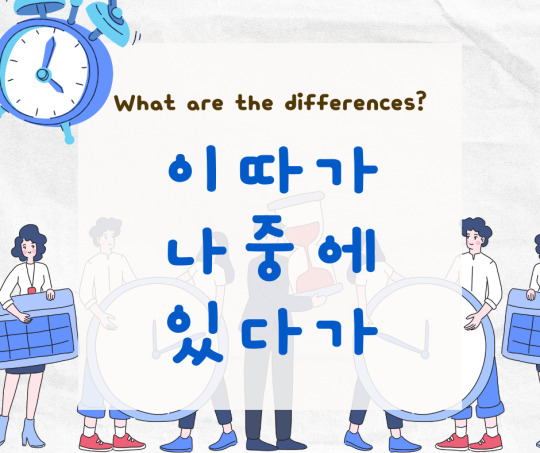
Differences between 이따가, 나중에 and 있다가
(1) "이따가" (ida-ga)
"이따가" can be translated to "later" or "sometime later" in English. It is used to refer to a specific point in the future that is not specified but is expected to happen soon. It can be used in situations where the speaker is not sure when exactly an event will happen, but they know it will happen in the near future.
E.g.
이따가 우리 함께 술 한 잔 할까?
(Shall we have a drink together later?)
(2) "나중에" (najung-e)
"나중에" can be translated to "later" or "in the future". It is used to refer to a point in the future that may be farther away than "이따가". It can be used in situations where the speaker is not sure when exactly an event will happen, but they know it will happen in the future.
E.g.
나중에 우리 같이 여행 가자.
(Let's go on a trip together later.)
In addition to the main difference, which is the point in time they refer to, there may be subtle differences in the level of formality or the level of certainty about the future event between "이따가" and "나중에":
- "이따가" is typically considered more informal and is often used in casual conversations, while "나중에" is considered more formal and is often used in more formal settings or in written language.
- "이따가" can imply that the speaker has a higher level of certainty that the event will happen, while "나중에" can imply that the speaker is less certain about the timing of the event.
E.g.
"이따가 우리 선물 교환하자" which is informal and means "Let's exchange gifts later"
"나중에 선물 교환을 할 수 있을 것 같아요" which is more formal and means, "I think we can exchange gifts later"
(3) "있다가" (it-da-ga)
Many people confuse "있다가" (it-da-ga) with "이따가" (ida-ga). Because they have a very similar pronunciation (발음). However, 있다가 is formed by 있다 and Verb-다가 grammar. Therefore, it is used to indicate that an action happened at a specific point in time while someone or something was present. "있다가" can be translated to "while (someone/something) is/was there" or "when (someone/something) is/was present".
E.g.
저는 친구들이 있다가 그들을 만났어요.
(I met my friends while they were there.)
#KoreanGrammar #KoreanLanguage #LearnKorean #Studywithme
🌸 🌼 🌻
Support me at: https://koreanlanguageloving.my.canva.site/
#Korean Grammar#Korean Vocabulary#Learn Korean#Study Korean#Korean Language#korean langblr#한국어 어휘#한국어 배우기#한국어공부중#한국어#한국어공부해요#한국어공부하기#한국어 공부하기#한국어공부#한국어배우기#한국어배우#Hangul
65 notes
·
View notes
Photo

"금방" and "방금" are both used to express the concept of "soon" or "quickly" but with slightly different meanings.
(1) "금방" (geumbang) is used to indicate that something will happen soon in the near future. It's like saying "in a short while" or "in no time."
E.g.
"금방 도착할 거예요" (I'll arrive soon).
"음식이 금방 나올 거예요." (The food will be served soon).
(2) "방금" (banggeum) refers to an event that happened a very short time before the present moment. It's often used to describe something that happened in the last few minutes. It's similar to the English expression "just now".
E.g.
"방금 전화가 왔어요" (A call just came in).
"방금 밥을 먹었어요." (I just ate).
In conclusion, while both words express the concept of "soon," they are used in different contexts. "금방" refers to a future event happening soon, while "방금" refers to a past event that just happened.
𝐄𝐱𝐭𝐫𝐚 𝐍𝐨𝐭𝐞𝐬:
In addition to "금방" and "방금," there are two other time-related expressions in Korean: "벌써" and "아까."
(3) "벌써" (beolsseo) is used to indicate that a significant amount of time has passed. It can be translated to "already" or "by now."
E.g.
"벌써 오후 6시예요" (It's already 6pm).
"벌써 한해가 지나갔어요" (A whole year has already passed).
(4) "아까" (akka) means "a while ago" or "some time ago". This word is often used to describe recent events and is similar to "방금." However, "아까" refers to a time in the past that is a little bit further back than "방금." It could mean a few minutes or even hours ago, depending on the context.
E.g.
"아까 친구와 전화했어요" (I just called a friend a little while ago).
"아까 비가 왔어요" (It rained a little while ago).
-
🌸 🌼 🌻
Support me at: https://koreanlanguageloving.my.canva.site/
#한국어 배우기#한국어배우기#한국어 단어#한국어 어휘#한국어능력시험#한국어#한국어 문법#Korean Language#Korean Study#korean langblr#Study Korean#Hangul#Korean Vocabulary#한국어공부#한국어공부해요#한국어공부중#한국어공부하기
50 notes
·
View notes